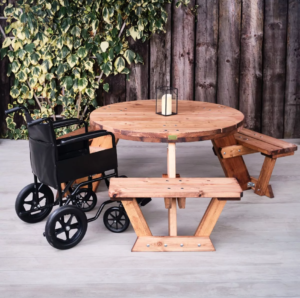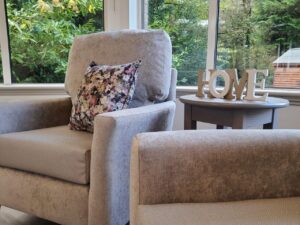Care home operators are once again turning their attention to refurbishing and upgrading their facilities, returning to projects they put on the back burner as the pandemic hit. Here, Russell Pillar, founder of Interiors by Amara Hammond, looks at some of the ways care homes can optimise their investment to support both their immediate needs and long-term goals, and explains how the right use of space is not just a matter of aesthetics but contributes to many vital aspects of running a home.
Providing care with style
The physical environment is instrumental in defining the quality of your care provision. Furniture, furnishings and flooring should be specifically designed for the care sector, where high levels of durability and ease of cleaning are prerequisites. There are many specialist, high performance upholsteries and textiles available on the market that offer all of the necessary properties – waterproof, wipeable, stain repellent and fire-rated to commercial standards. Using fire-retardant sprays on curtains is still quite common but as they lose their effectiveness after a few washes at high temperature, the curtain fabric itself should have flame retardancy built in. In addition, we are seeing more operators in the post-Covid era specify fabrics featuring innovative anti-microbial technology, helping to ramp up the inherent germ resistance of the home and prevent the spread of infections.
Importantly, even interiors with highly technical profiles are a world away from the institutional look and feel of years gone by. Many care home managers are surprised that anti-microbial textiles including curtains now come in a wide range to suit all design and care considerations. The same is true for furniture and flooring. Care attributes naturally come first – such as chairs with reinforced frames or pressure-relieving cushions, low profile or adjustable beds, anti-slip safety vinyl and even flooring with sound absorbing qualities – but these can all be compatible with a modern design scheme.
Lissa di Giacomo, Managing Director of Oakminster Healthcare, which operates five care homes in Glasgow, testifies to this:
“Today it is perfectly possible to specify practical, high-performing interiors that have the shelf-life necessary for the care environment without compromising on comfort, style and homeliness. For instance, we recently opted for a new range of vinyl flooring that looks just like material but is still durable enough to withstand deep-cleaning”
In our experience, the practice of procuring domestic-grade interiors from high-street retailers is becoming less prevalent in the sector. Some operators have chosen this route in the past believing it to be a cheap, quick fix – especially if single items need replacing. However, this will undermine safety and compliance standards, and is unlikely to be cost-effective even in the short-term because most products are not sufficiently hard-wearing to withstand the demands of the care environment. One manager we spoke to recently reported that they had seen high street sofas last six months. Rethinking your procurement strategy in alignment with a longer-term, well thought-out design vision will pay dividends, whether you are replacing individual items or undertaking a complete refurbishment.
With the care sector facing a major recruitment and retention crisis, caring for carers simply must not be overlooked. In a bid to attract new staff and improve the appeal of the home as a workplace, many operators are recognising that they must go beyond their legal obligations as an employer and seek to fully understand and meet staff expectations. As a starting point, any investment in interiors should extend to staff facilities, upgrading the comfort of areas designed for breaks during the day or for overnight stays. Equally, having the right equipment at your carers’ disposal is not only crucial to the quality of care they provide but to their safety, confidence and overall satisfaction at work.
Inclusivity and personalisation – the hallmarks of outstanding provision
Our surroundings play a key role in making everyone feel included and valued. To deliver person-centred care, homes should reflect the interests, background, identity and locality of service users. There are many ways that this can be achieved; for instance, design in communal areas could be linked to residents’ past lives. A good example is a home for former servicemen and women incorporating military-related accessories into its interiors, or a design scheme that draws inspiration from the history and location of the home. In bedrooms, residents can be given the opportunity of personalising their space through memory boxes or cabinets displaying photographs and other memorabilia. These are a great way to link the past to the present, foster a sense of familiarity, and inspire personal connection with other residents and carers.
 Accessibility is a vital consideration when specifying interiors, especially for homes caring for those with physical disabilities, mobility difficulties or cognitive conditions. Specially designed furniture, such as tables with gaps for wheelchairs, can be a good option and make both indoor and outdoor spaces more inclusive. It’s also important to avoid a ‘one-size-fits-all’ approach to seating in lounges and communal areas. Offering a range of options with higher and lower profiles, as well as some with in-built pressure care, will better meet the varying needs of your service users.
Accessibility is a vital consideration when specifying interiors, especially for homes caring for those with physical disabilities, mobility difficulties or cognitive conditions. Specially designed furniture, such as tables with gaps for wheelchairs, can be a good option and make both indoor and outdoor spaces more inclusive. It’s also important to avoid a ‘one-size-fits-all’ approach to seating in lounges and communal areas. Offering a range of options with higher and lower profiles, as well as some with in-built pressure care, will better meet the varying needs of your service users.
Interiors can make all the difference to those living with dementia. As Lesley Palmer, Chief Architect, Dementia Services Development Centre at the University of Stirling* writes:
“The design of the built environment can have a profound impact on how a person with dementia perceives, experiences and engages with the places and spaces in which they live.”
*Why green spaces, walkable neighbourhoods and life-enhancing buildings can all help in the fight against dementia, The Conversation.com, September 2020
For instance, beds should be positioned so that residents have a direct view of those entering their room so they do not have to rely on peripheral vision. Contrasting colours should be used for walls and flooring, and plain patterns chosen for upholstery. Glass should be avoided to minimise confusion. Dementia-specific furniture may include open sections on wardrobes so that clothes can be easily seen and accessed; cut-out scoop handles on drawers; and rounded corners on all units. The latest ranges of specialist furniture successfully blend function, homeliness and visual appeal.
Involving both residents and staff appropriately in interiors projects can be a highly effective way to foster a collaborative environment where ideas and feedback are encouraged. In fact, the CQC’s guidance for service users and families when choosing a care home stipulates that “you are asked for your likes and needs when the home is adapted or decorated.” A best-practice way of implementing this in your care home is to involve key staff from the outset of a project, so they feel involved, can have their say and bring ideas to the table. Further down the line, residents could be shown your short-list of designs, perhaps at a roundtable-style discussion. Helping them to feel they have contributed to making final decisions regarding their surroundings is a powerful way of promoting engagement and inclusion within the home.
Designing the future of your home
Reconsidering how to use each of the spaces within your home can improve revenue generation opportunities that pay off handsomely. Choosing a more suitable layout and better fitting furniture, in combination with a coherent design scheme, can completely transform a space. For instance, an odd-shaped room can be optimised by steering clear of standard furniture and choosing specialist alternatives in bespoke sizes that make it cosy rather than cramped. Conversely, a well-considered layout can break up large rooms so they are welcoming and inclusive rather than noisy and overwhelming. Some rooms may be suitable for conversion into private flats, or a communal area that is under-used could be turned into a popular themed space such as a library, tea room or indoor garden room.
 Stylistic decisions should be guided by – and complement – the characteristics of your properties, ensuring that any projects are undertaken firmly in keeping with their age and history. When it comes to purpose-built developments, the right interiors can help to banish the ‘new build’ feel that may deter some residents and families, upping the all-important homeliness factor. First impressions count – and the impact of interiors from a purely aesthetic point of view should not be underestimated.
Stylistic decisions should be guided by – and complement – the characteristics of your properties, ensuring that any projects are undertaken firmly in keeping with their age and history. When it comes to purpose-built developments, the right interiors can help to banish the ‘new build’ feel that may deter some residents and families, upping the all-important homeliness factor. First impressions count – and the impact of interiors from a purely aesthetic point of view should not be underestimated.
From all stakeholders’ perspectives, the physical surroundings are a reflection of a care operator’s commitment to protecting residents and staff while creating a comfortable, inclusive and ‘home from home’ environment. From the quality of your care provision and the safety of the home as a workplace, to its very commercial viability and overall appeal – interiors matter. Operators are therefore considering their design decisions very carefully as we emerge from the Covid-19 pandemic and ensuring that every penny spent delivers on care, compliance and commercial goals.

